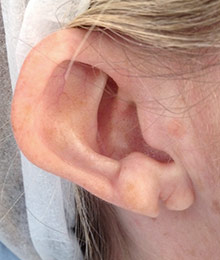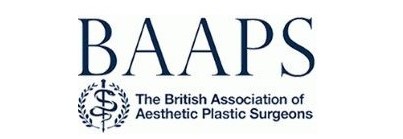Earlobe surgery
What is earlobe repair surgery?
Earlobe repair surgery is a procedure that aims to correct and restore the appearance of damaged, torn, or stretched earlobes. The surgery is performed by a plastic surgeon and is typically done under local anaesthesia. The main goal of earlobe repair surgery is to improve the overall appearance and symmetry of the earlobes while maintaining a natural-looking result. Common reasons for seeking earlobe repair include trauma, injury, wearing heavy or improperly worn earrings, gauged or stretched earlobes, and congenital deformities.
Common reasons for earlobe repair
1 Trauma or injury: Accidents, such as earrings getting caught on clothing, hairbrushes or pulled by children, can cause the earlobe to tear partially or completely. This may result in an uneven or split earlobe usually requires surgical repair to restore its original appearance.
2 Heavy or improperly worn earrings: Over time, wearing heavy or dangling earrings can cause the earlobe to stretch or elongate. This can lead to sagging earlobes and widened earring holes, which may negatively affect the appearance of the ear and make it difficult to wear earrings properly.
3 Gauged or stretched earlobes: Body modification practices, such as earlobe stretching with the use of gauges or plugs, can lead to significantly enlarged earlobe holes. If an individual decides to reverse this, earlobe repair surgery can help close the holes and restore a more natural earlobe appearance.
4 Congenital deformities: Some people are born with earlobe abnormalities or deformities, such as overly large, small, or asymmetrical earlobes. Earlobe repair surgery can be performed to correct these congenital issues and improve the overall appearance of the ears.
5 Aging: As people age, the earlobes may lose volume and elasticity, resulting in sagging or drooping earlobes. Earlobe repair surgery can help restore a more youthful appearance by reshaping and lifting the earlobes.
6 Keloids or hypertrophic scars: Some individuals may develop excessive scar tissue (keloids or hypertrophic scars) in the earlobe area after an injury or piercing. This can cause discomfort and cosmetic concerns. The scar can be treated to improve the appearance of the earlobe.
7 Personal preference: In some cases, people may seek earlobe repair surgery to address aesthetic concerns that are not related to any specific injury or condition. For example, they may desire a more symmetrical or balanced appearance of their earlobes to enhance their overall facial harmony.
Importance of earlobe repair for self-confidence and aesthetic balance
The importance of earlobe repair for self-confidence and aesthetic balance lies in the role that the ears and earlobes play in overall facial appearance. Earlobes, although small, are a significant part of the ears and can significantly impact an individual’s self-image and confidence. Here are some reasons why earlobe repair can help improve self-confidence and aesthetic balance:
1 Facial symmetry: Symmetry plays a crucial role in how we perceive attractiveness. Damaged, stretched, or uneven earlobes can disrupt facial symmetry and create an imbalanced appearance. Earlobe repair surgery can restore symmetry by repairing and reshaping the earlobes, enhancing overall facial harmony.
2 Improved self-confidence: A person’s self-confidence can be directly impacted by their appearance. When someone feels self-conscious about their earlobes, it can affect their social interactions and overall self-esteem. By repairing damaged or deformed earlobes, individuals can regain their confidence and feel more comfortable in various situations, such as wearing earrings or pulling their hair back.
3 Restoring a natural appearance: Earlobe repair surgery aims to restore the natural shape and size of the earlobes, which can significantly improve a person’s overall appearance. This can be especially important for those who have experienced trauma or have undergone body modifications, for example with ear devices designed to create a tunnel appearance to the earlobe, and wish to return to a more traditional earlobe appearance.
4 Better earring support: Damaged or stretched earlobes can make it difficult to wear earrings properly. Repairing the earlobes can provide better support for earrings, allowing individuals to comfortably wear various types of earrings without worrying about them slipping out or causing further damage to the earlobe. It is important not to re-pierce the area of the scar.
5 Psychological well-being: Feeling satisfied with one’s appearance can contribute to improved mental health and well-being. Addressing aesthetic concerns, such as earlobe deformities, can help individuals feel more content with their appearance and reduce stress or anxiety related to their perceived flaws.
Earlobe repair surgery can have a significant impact on an individual’s self-confidence and aesthetic balance. By addressing issues with earlobes, people can improve their overall facial appearance, feel more comfortable in social situations, and enhance their psychological well-being.
The Earlobe Repair Procedure
The earlobe repair procedure typically takes place in an outpatient setting. The process can be broken down into several steps:
Consultation: Prior to the surgery, the patient will have a consultation with their plastic surgeon. During this appointment, the doctor will assess the patient’s earlobe condition, discuss their goals and expectations, explain the surgical procedure, and address any potential risks and complications.
Surgical techniques: Depending on the specific issue to be addressed, the surgeon will select the most appropriate technique for the earlobe repair. Some common methods include:
a. Direct repair: This technique involves excising the damaged tissue, freshening the edges of the tear, and suturing the wound closed. This is typically used for simple, straight tears or small notches.
b. Z-plasty technique: For more complex tears or to reduce tension in the repair, a Z-plasty technique may be used. This involves creating small, triangular flaps of skin on either side of the tear and rearranging them in a Z-shape to close the wound and redistribute tension.
c. Flap-based techniques: In cases of significant tissue loss or stretched earlobes, the surgeon may use a flap-based technique to reconstruct the earlobe. This involves creating local tissue flaps that can be rearranged to restore the earlobe’s shape and size.
Earlobe repair surgery is usually performed under local anaesthesia, which numbs the area but keeps the patient awake.
Post-operative care instructions: After the procedure, the surgeon will provide the patient with detailed instructions on how to care for their earlobes during the healing process such as keeping the area clean and dry.It is essential to follow the surgeon’s post-operative care instructions to ensure proper healing and achieve the best possible results.
Recovery and Healing
Recovery and healing after earlobe repair surgery are generally straightforward. Here is an overview of what you can expect during the recovery process:
Immediate post-operative period: After the procedure, you may experience some mild pain, swelling, and bruising in the treated area. Pain can be managed with over-the-counter pain relievers or prescribed medications, as recommended by your surgeon. Applying a cold compress to the area can also help alleviate swelling and discomfort.
Wound care: It is essential to keep the surgical area clean and dry to prevent infection and promote healing. You will be given instructions on how to clean the area, and change dressings as needed. It is crucial to follow these guidelines and contact the surgeon if any signs of infection or complications arise.
Timeline for recovery: Earlobe repair surgery typically has a short recovery period. Stitches are usually removed 7 days after the procedure. Most people can resume their daily activities within a couple of days, although strenuous activities should be avoided for at least 2 weeks to reduce complications.
Return to work or school: Most people can return to work or school within a couple of days after the procedure, depending on the nature of their job or daily activities. It is essential to discuss any concerns with your surgeon and follow their guidance on when to resume specific tasks.
Long-term care and maintenance: To ensure the best possible results and minimize scarring, patients should follow any long-term care recommendations provided by the surgeon. This may include scar care and massage, sun protection, and guidelines on when and how to wear earrings again.
Overall, recovery and healing from earlobe repair surgery are typically quick and uneventful. By following your surgeon’s post-operative instructions and taking care of the surgical area, you can expect to see an improvement in the appearance and symmetry of their earlobes within a few days.
Frequently Asked Questions
A. Can I wear earrings after earlobe surgery?
After undergoing earlobe repair surgery, it’s crucial to follow specific guidelines regarding earring usage to ensure proper healing and prevent complications. Here are some general earring usage guidelines for people who have had earlobe repair surgery:
1 Wait for clearance from the surgeon: Do not wear earrings until the surgeon has cleared you to do so. This typically occurs once the earlobe has fully healed, usually after 6-8 weeks, but the exact timeline may vary depending on individual healing rates.
2 Start with lightweight earrings: When you are cleared to wear earrings again, begin with small, lightweight earrings to minimize pressure on the earlobe. Avoid heavy, large, or dangling earrings initially, as these can strain the repaired area and potentially cause damage.
3 Use hypoallergenic materials: Choose earrings made from hypoallergenic materials, such as surgical steel, titanium, or gold, to reduce the risk of irritation or allergic reactions. Avoid earrings made from nickel or other materials that may cause sensitivity.
4 Keep earrings clean: To minimize the risk of infection, make sure to keep your earrings clean. Clean both the earrings and earlobes with rubbing alcohol or an antiseptic solution before and after wearing them.
5 Avoid sleeping with earrings: Remove your earrings before going to bed to reduce the risk of accidental pulling or snagging, which could cause damage to the repaired earlobe.
6 Monitor for any signs of irritation or infection: Pay close attention to how your earlobes react to wearing earrings again. If you notice any signs of irritation, swelling, redness, or discharge, remove the earrings immediately and contact your surgeon for further guidance.
7 Re-piercing guidelines: If your earlobe repair surgery involved closing a previous piercing, you may need to wait several months before re-piercing the earlobe. Consult with your surgeon to determine the appropriate timeline and to ensure the new piercing is placed correctly to avoid damage to the repaired area.
Avoid re-piercing the ear in line with the new scar as the tissue will be weaker.
By following these earring usage guidelines after earlobe repair surgery, you can maintain the corrected appearance of your earlobes while enjoying the versatility and style that earrings offer. Always consult with your surgeon for personalized recommendations and guidelines based on your specific situation and healing progress.










